Choosing the right softball glove is crucial for performance and comfort. Glove size depends on age, position, and hand size, ensuring a proper fit for optimal play.
The Importance of Proper Fit in Softball Gloves
A proper fit in a softball glove is essential for optimal performance and comfort. A well-fitted glove ensures better control, accuracy, and confidence while playing. It allows for a snug yet comfortable feel, preventing discomfort during long games. Incorrect sizing can lead to poor grip, reduced dexterity, or even injuries. A glove that is too tight may restrict movement, while one that is too loose can hinder performance. Proper fit also enhances the ability to catch, throw, and field effectively. Ensuring the right size is crucial for both experienced players and beginners to maximize their skills and enjoyment of the game.
Types of Softball Gloves: Differences and Uses
Softball gloves vary by position, with each designed for specific roles. Infielder gloves are smaller, typically 11.5-12 inches, allowing quick transfers and precise control. Outfielder gloves are larger, 12-13 inches, with deeper pockets for catching fly balls. Pitcher’s gloves are 11.5-12.5 inches, focusing on concealment and comfort. Catcher’s mitts are the largest, 12-13 inches, with extra padding to handle fast pitches. Each type is tailored to the demands of the position, ensuring optimal performance. Understanding these differences helps players choose the right glove for their role, enhancing both functionality and overall gameplay effectiveness.
How to Use This Glove Size Guide Effectively
To use this glove size guide effectively, start by identifying your position and age group, as these are key factors in determining the right size. Refer to the sizing charts provided, which categorize gloves by position, age, and hand size. Measure your hand accurately to match it with the corresponding glove size. Consider your personal comfort and the specific demands of your role on the field. Try on gloves if possible to ensure a snug, comfortable fit. By following these steps, you can select a glove that enhances your performance and provides long-lasting comfort during games and practices.

Factors Determining Softball Glove Size
Age, skill level, hand size, and position are key factors in determining the ideal softball glove size, ensuring proper fit and performance for players of all levels.
Age and Skill Level: Choosing the Right Size
A player’s age and skill level significantly influence softball glove size. Youth players typically require smaller gloves to ensure proper control and dexterity, while older, more experienced players often prefer larger sizes for better performance. Beginners benefit from smaller gloves to develop fundamental skills, as larger gloves can be cumbersome. Intermediate and advanced players may opt for slightly larger sizes depending on their position and hand size. It’s important to select a glove that fits well now, rather than choosing a larger size for future growth, to ensure optimal comfort and functionality during games and practices.
Hand Size and Its Impact on Glove Fit
Hand size plays a critical role in determining the ideal softball glove fit. A glove that is too tight can restrict movement, while one that is too loose may hinder control. Proper fit ensures comfort and optimal performance. Measure your hand accurately, including the length from the wrist to the tip of your middle finger, to find the right size. Players with larger hands may prefer gloves with longer fingers for better grip, while smaller hands benefit from snug, compact designs. Ensure the glove feels comfortable and allows for easy movement, as proper fit directly impacts fielding and throwing ability.
Position-Specific Glove Sizes
Softball glove sizes vary by position due to differing demands of each role. Infielders require smaller gloves (11-12 inches) for quick throws and ball control, while outfielders need larger gloves (12-14 inches) to catch fly balls effectively. Pitchers often prefer gloves with a closed web for better ball concealment, typically in the 11.5-12.5 inch range. Catchers use mitts with extra padding for protection, usually sized between 12-13 inches. Each position’s glove size is designed to optimize performance, ensuring players can execute their specific duties comfortably and efficiently. Proper sizing enhances fielding, throwing, and overall gameplay effectiveness.

Player’s Personal Preference and Comfort
Player’s personal preference and comfort play a significant role in choosing a softball glove. While size charts provide a starting point, individual comfort and feel are equally important. Some players prefer a snug fit for better control, while others opt for a bit more room for ease of movement. The type of material, padding, and web design also influence comfort. Trying on gloves allows players to assess how the glove feels and performs. Ultimately, a glove that balances fit, comfort, and functionality ensures peak performance and satisfaction. Personal preferences often dictate the final choice, making it crucial to prioritize comfort during selection.
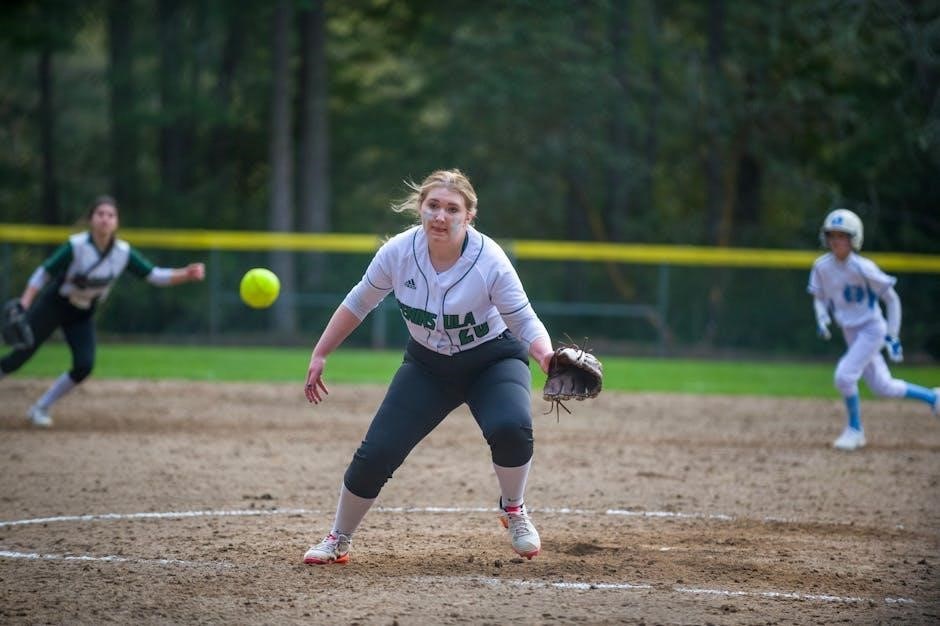
Measuring Your Hand for a Softball Glove
Accurate hand measurement is essential for selecting the right glove size. Use a tape measure or sizing chart to ensure a proper fit and comfort.
How to Measure Your Hand Size Accurately
To measure your hand size accurately for a softball glove, start by using a flexible tape measure. Wrap it around the widest part of your hand, just above the knuckles, excluding your thumb. Ensure the tape is snug but not overly tight. Record the circumference in inches. Some sizing charts may also require the length from the tip of your middle finger to the base of your wrist. Avoid including the thumb in your measurement, as it can distort the size. Keeping your fingers together during the process ensures accuracy. This method helps determine the ideal glove fit for comfort and performance.
Understanding Glove Sizing Charts
Glove sizing charts are essential tools for selecting the right softball glove. They typically list sizes in inches, ranging from 8 to 15, with specific recommendations based on position and age. For example, infielders often use smaller gloves (9-11 inches), while outfielders prefer larger ones (12-14 inches) for catching fly balls. Catcher’s mitts are sized differently, focusing on fit and padding rather than length. Charts may also differentiate between fastpitch and slowpitch softball, as well as youth and adult players. By understanding these charts, players can match their hand size, position, and skill level to the ideal glove, ensuring comfort and performance.
Converting Measurements to Glove Sizes
Converting hand measurements to glove sizes involves correlating palm size with standard glove dimensions. Measure your hand’s circumference just above the wrist, excluding the thumb, to determine your glove size. Most softball gloves range from 8 to 15 inches, with smaller sizes for younger players and larger sizes for outfielders. For example, a 7-inch hand circumference typically aligns with a 10-11 inch glove. Use sizing charts to match your measurement to the appropriate glove size, ensuring a snug yet comfortable fit. Proper conversion ensures optimal performance and comfort, whether you’re an infielder, outfielder, or catcher.
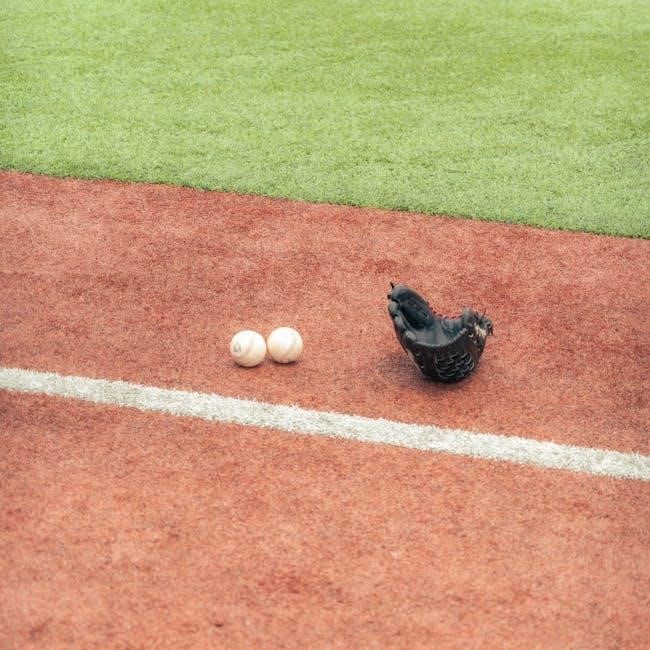
Position-Specific Glove Size Recommendations
Each softball position requires specific glove sizes for optimal performance. Outfielders need larger gloves for fly balls, while infielders prefer snug fits for quick exchanges. Pitchers opt for smaller sizes, and catchers use specialized mitts.
Infielder Glove Sizes and Features
Infielders typically use gloves between 11.5 and 12.5 inches, offering a snug fit for quick ball transfers. These gloves feature shallow pockets and shorter fingers for rapid exchanges. The leather is durable, with padding on the back and reinforced palms for protection. Web styles vary, but most infielders prefer open or H-webs for better control. Youth players may opt for smaller sizes, around 11 inches, ensuring easy maneuverability. Proper sizing ensures infielders can quickly scoop and throw, making them essential for defensive play in fast-paced games.
Outfielder Glove Sizes and Designs
Outfielder gloves are larger, typically ranging from 12.5 to 14 inches, allowing for a deeper pocket to securely catch fly balls. These gloves have longer fingers and a more substantial design to handle high-speed catches. The leather is sturdy, offering durability and support. Outfield gloves often feature H-webs or closed webs for added strength. Proper sizing ensures comfort and control, with a snug fit to prevent the glove from feeling bulky. Youth outfielders may prefer slightly smaller sizes, around 12 inches, to maintain agility. The right design and size enable outfielders to make precise catches and throws, enhancing overall performance on the field.
Pitcher’s Glove: Size and Style Considerations
Pitcher’s gloves are smaller, typically ranging from 11.5 to 12.5 inches, allowing for better control and quick ball movement. The design emphasizes concealment, with closed webs to hide the ball during pitches. The smaller size ensures a snug fit, enabling precise grip and faster transfers. Pitchers often prefer gloves with minimal padding to maintain feel and dexterity. The leather should be durable yet flexible, providing support without restricting movement. Proper sizing is critical, as a glove too large can hinder control, while one too small may not provide adequate protection. The right style and fit help pitchers perform effectively, combining comfort and functionality for peak performance on the mound.
Catcher’s Mitt: Size and Fit Guidelines
Catcher’s mitts are larger and more padded than other gloves, typically ranging from 33 to 35 inches in circumference; They are designed to handle high-speed pitches and provide protection for the hand. The mitt should fit snugly, allowing for full finger movement and control. Proper padding in the palm and fingers is essential for absorbing impact. The webbing style is usually closed to help secure the ball. A well-broken-in mitt ensures comfort and performance. Catchers often prefer a slightly tighter fit to maintain grip and prevent shifting during plays. The right size and fit are critical for effective catching and throwing.

Softball Glove Size Chart by Age and Position
Size charts categorize gloves by age and position, ensuring optimal fit and performance. Youth players (under 7) use smaller gloves, while adults require larger sizes. Positions like infield, outfield, and catcher have tailored sizes for specific needs, ensuring proper fit and control.
Fastpitch Softball Glove Sizing Chart
A fastpitch softball glove sizing chart helps players choose the right fit based on age and position. For younger players (under 7), gloves range from 9 to 11 inches, while older players (11-13) use 11.5 to 12-inch gloves. Infielders typically prefer smaller gloves for quicker transfers, while outfielders opt for larger sizes to catch fly balls. The chart also differentiates between first basemen and pitchers, offering specific size recommendations. Proper fit ensures better control and performance, making the chart an essential tool for players of all skill levels. It’s designed to guide selections accurately for optimal gameplay.
Slowpitch Softball Glove Size Recommendations
Slowpitch softball glove sizes vary slightly from fastpitch, with adult players typically using gloves between 12 and 14 inches. Youth players often prefer smaller sizes, around 10 to 12 inches, depending on their hand size and position. Infielders may opt for shorter gloves (12-12.5 inches) for quicker transfers, while outfielders and first basemen benefit from larger sizes (13-14 inches) for better catching ability. The chart recommends sizes based on age and position, ensuring a comfortable fit and optimal performance. Proper sizing is essential for control and confidence in slowpitch games, where the ball is pitched at a slower pace but requires precise handling.
Youth Softball Glove Sizes for Young Players
Youth softball gloves are designed to fit smaller hands, promoting proper technique and comfort. Players under 7 typically use 9-10 inch gloves, while those aged 8-10 prefer 10-11.5 inches. Young infielders often choose smaller sizes for quicker ball transfers, while outfielders may opt for slightly larger gloves. The chart provides specific size ranges, ensuring a snug fit that allows young players to develop their skills effectively. Proper sizing is crucial to prevent discomfort and enhance performance, helping young athletes build confidence in their abilities from an early age.
Adult Softball Glove Sizes: Men and Women
Adult softball gloves typically range from 12 to 14 inches for most positions, with slight variations for men and women. Men generally prefer larger sizes for better control, while women often opt for slightly smaller gloves for a snug fit. Infielders and pitchers may choose 11.5-12.5 inches, while outfielders prefer 12-14 inches. Catchers’ mitts are larger, usually 12-13 inches. Fastpitch gloves for women are similar but tailored for smaller hands. Proper sizing ensures comfort and performance, allowing players to grip and throw effectively. Choosing the right size is essential for optimal gameplay and protection, regardless of position or skill level.
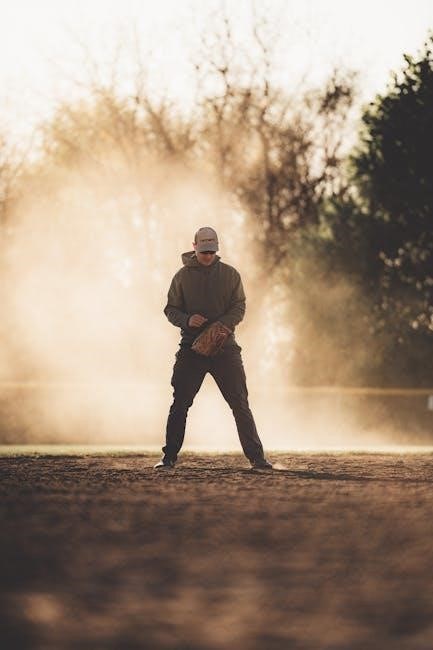
Materials and Construction of Softball Gloves
Softball gloves are crafted from durable materials like leather or synthetic fabrics. Leather offers superior feel and longevity, while synthetic options are lighter and easier to break in. Proper padding enhances comfort and protection, with webbing designs improving flexibility and performance.
Leather vs. Synthetic Materials: Which is Better?
When selecting a softball glove, the choice between leather and synthetic materials depends on personal preference and playing level. Leather gloves are preferred by many due to their durability and natural feel, offering a superior grip and break-in period. They mold to the player’s hand over time, providing a customized fit. Synthetic gloves, on the other hand, are lighter, easier to maintain, and quicker to break in, making them ideal for younger players or those on a budget. Both materials have their advantages, and the decision ultimately comes down to the player’s needs and experience level.
The Role of Padding in Glove Comfort and Protection
Padding in softball gloves plays a crucial role in both comfort and protection. It cushions the hand against the impact of the ball, reducing sting and discomfort. Thicker padding is often found in catcher’s mitts and first baseman’s gloves to handle high-velocity throws and wild pitches. Infielders may prefer less padding for better ball control and feel. Proper padding ensures long-lasting comfort during games and practices. It also helps prevent injuries by absorbing shock. The right amount of padding can enhance performance, allowing players to focus on the game without discomfort. Balancing padding with flexibility is key for optimal protection and mobility.
Webbing Types and Their Impact on Performance
Softball gloves feature various webbing designs that significantly impact performance. The web is the part connecting the thumb and index finger; Closed webbing, common in pitchers’ gloves, conceals the ball better, aiding deception. Open webbing, popular among infielders, allows quicker ball transfers. Double-T and single-T webs offer a balance between visibility and control. Each web type affects how the ball is handled and thrown. Proper web selection enhances fielding, throwing accuracy, and overall gameplay efficiency. Players should choose webbing based on their position and style to maximize performance and comfort during the game.
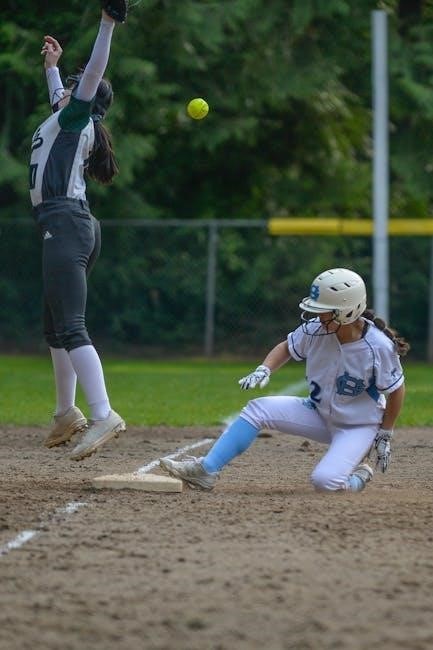
Popular Brands and Their Glove Sizes
Top brands like Wilson, Rawlings, and Easton offer a variety of softball glove sizes. Wilson’s A2000 and Rawlings’ Quatro are popular choices, while Easton’s Ghost series provides unique styling.
Wilson Softball Gloves: Sizes and Models
Wilson is a trusted brand in softball, offering high-quality gloves tailored to various positions and player preferences. Their A2000 series is popular among infielders and outfielders, with sizes ranging from 11.5 to 13 inches, designed for precise control and durability. The A500 series is ideal for younger players, featuring smaller sizes like 11 inches for better fit and maneuverability. Wilson also offers the Spin model, known for its unique design and flexibility, catering to pitchers who need a snug, responsive glove. With a focus on both performance and comfort, Wilson provides a wide range of options to suit different skill levels and playing styles, ensuring optimal fit and functionality.
Rawlings Softball Gloves: Size and Fit Options
Rawlings offers a diverse selection of softball gloves, catering to various player needs. Their Glove Series includes models like the Liberty Advanced, designed for female athletes, featuring sizes from 11.5 to 12.5 inches. The Quatro Pro series is popular among infielders, offering sizes between 11 and 11.75 inches for quick transitions. Rawlings also provides options for younger players, such as the Renegade series, with smaller sizes like 10 inches for better control. Each glove is crafted with attention to detail, ensuring a snug, responsive fit. Rawlings emphasizes comfort and durability, making their gloves a top choice for players seeking both performance and long-lasting quality in their equipment.
Easton Softball Gloves: Size and Style Varieties
Easton softball gloves are renowned for their innovative designs and customizable fit options. The Ghost series is a popular choice, offering sizes from 11.5 to 13 inches, ideal for infielders and outfielders. Easton’s Professional Collection provides a sleek, modern look with sizes ranging from 11 to 12.5 inches, catering to players seeking precision and control. Youth players benefit from Easton’s smaller sizes, such as 10 inches, designed for younger hands. The gloves feature high-quality leather and advanced padding for comfort. Easton also offers adjustable wrist straps, allowing for a tailored fit. With a focus on performance and style, Easton gloves are a favorite among players at all skill levels.
Other Reputable Brands and Their Glove Sizes
Beyond Wilson, Rawlings, and Easton, other reputable brands like Mizuno, Louisville Slugger, and Marucci offer high-quality softball gloves. Mizuno gloves are known for their sleek designs and precise fit, available in sizes from 11 to 13 inches. Louisville Slugger provides classic styles with sizes ranging from 11.5 to 12.75 inches, catering to both infield and outfield positions. Marucci gloves, favored for their premium materials, come in sizes from 11 to 12.5 inches, offering durability and comfort. These brands also offer youth sizes, such as 10 inches, ensuring younger players can find a glove that fits perfectly. Each brand tailors its designs to meet the needs of players at various skill levels and positions, ensuring optimal performance and comfort.

Glove Maintenance and Longevity
Regular cleaning, conditioning, and proper storage extend a softball glove’s lifespan. Use leather conditioners and avoid extreme temperatures to maintain shape and prevent cracking.
How to Clean and Condition Your Softball Glove
Cleaning and conditioning your softball glove regularly ensures durability and maintains its performance. Start by gently wiping away dirt with a soft cloth. For deeper cleaning, mix mild soap with warm water and apply it to the leather using a clean, damp cloth. Avoid harsh chemicals or excessive water, as they can damage the material. After cleaning, allow the glove to air dry naturally. Once dry, apply a leather conditioner to keep the glove supple and prevent cracking. Regular conditioning helps extend the life of your glove and ensures it remains comfortable and responsive during play.
Breaking In a New Glove: Tips and Tricks
Breaking in a new softball glove is essential for optimal comfort and performance. Start by applying a small amount of leather conditioner to soften the material. Use a mallet or the heel of your hand to gently pound the leather, focusing on the palm and fingers. Bend the glove repeatedly to create flexibility. For the pocket, roll the glove and squeeze it tightly, then release. Wear the glove during practice to shape it to your hand. Avoid using harsh chemicals or excessive heat, as this can damage the leather. With patience and proper care, your glove will mold to your hand, ensuring a snug, responsive fit.
Storing Your Glove Properly to Maintain Shape
Proper storage is key to maintaining your softball glove’s shape and longevity. After use, allow the glove to air dry naturally, avoiding direct sunlight or heat. Store it in a cool, dry place, away from moisture. Do not leave the glove in a tight space or bent position, as this can cause creases or misshaping. Consider placing a ball in the pocket to maintain its form. For extended storage, use a glove bag or wrap it in a dry cloth to protect it from dust. Regularly inspect the glove for signs of wear and ensure it remains clean and conditioned.
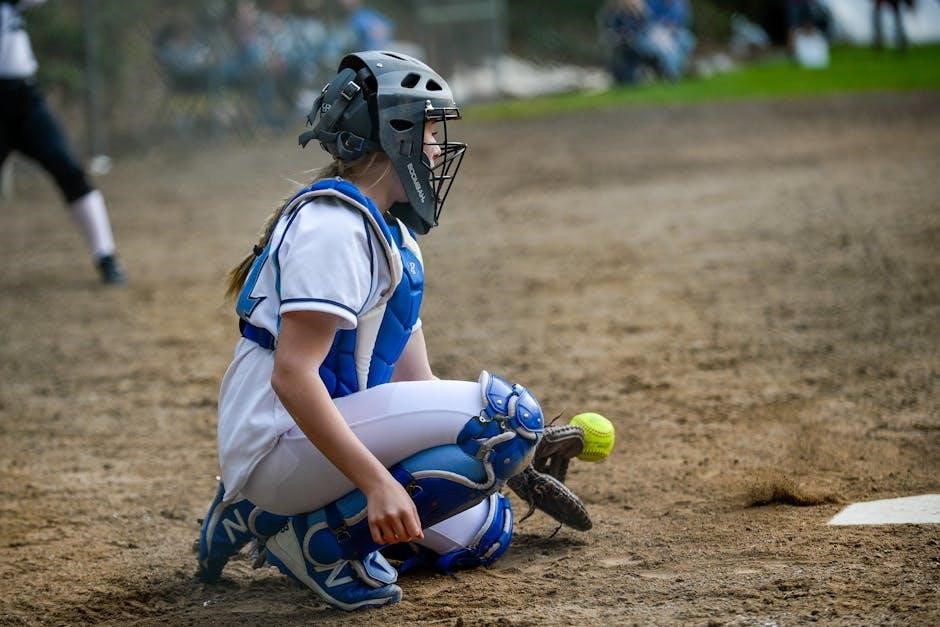
Tips for First-Time Buyers
First-time buyers should use sizing charts, consider position and age, try gloves on, and ensure a snug fit for optimal performance and comfort.
What to Look for When Buying a Softball Glove
When buying a softball glove, consider size, material, and position-specific features. Use sizing charts to match your age and position. Leather gloves are durable, while synthetic options are lightweight. Ensure the glove fits snugly, as a loose fit can hinder performance. Try on gloves to check for comfort and flexibility. Position-specific features, like a larger pocket for outfielders or a smaller one for infielders, are key. Webbing type and padding also impact functionality. Don’t buy a glove that’s too big, as it may take longer to break in; Proper fit ensures better control and accuracy during plays.
Trying on Gloves: What to Expect
When trying on softball gloves, expect a snug, comfortable fit that allows for easy movement. Ensure the glove isn’t too tight or restrictive. Pay attention to the padding, especially around the palm and fingers, for adequate protection. Check the webbing type, as it affects how the ball is caught. If trying on a new glove, consider the break-in period—some gloves may feel stiff initially. Compare different models to find the one that feels most natural. If possible, try gloves with your baseball bat or ball to simulate game conditions. Don’t hesitate to ask for advice from experienced players or store experts to ensure the best fit and performance.
Common Mistakes to Avoid When Choosing a Glove
One common mistake is buying a glove that’s too large, thinking it will allow for growth, which can hinder control. Avoid ignoring position-specific features, as they drastically impact performance. Many players overlook the importance of proper break-in, leading to discomfort during games. Don’t assume all gloves are the same—materials and webbing vary, affecting functionality. Trying on multiple gloves is crucial, as fit and feel can differ greatly. Lastly, don’t rush the process; take time to ensure the glove aligns with your needs and preferences. By avoiding these mistakes, you’ll find a glove that enhances your game and provides long-term satisfaction.
Selecting the right softball glove is a personal process. Use this guide to find a glove that fits your position, age, and style, ensuring optimal performance and comfort.
Final Thoughts on Selecting the Right Softball Glove
Selecting the right softball glove is a key decision that impacts performance and comfort. Proper fit ensures better control and confidence on the field. Consider age, position, and personal preference when choosing. A well-fitting glove enhances skill development and overall enjoyment of the game. Use this guide to make an informed decision, ensuring your glove aligns with your needs. Remember, the right glove is an investment in your softball journey, helping you play your best game every time. Always refer to sizing charts and expert recommendations for future purchases to maintain optimal performance and satisfaction.
Encouragement to Use the Guide for Future Purchases
This guide is a valuable resource for selecting the perfect softball glove, ensuring optimal performance and comfort. As your softball journey progresses, your needs may evolve, and this guide will remain a trusted companion. Whether you’re growing into a new position or upgrading your gear, refer back to these insights to make informed decisions. Consistent use of this guide guarantees you’ll always find a glove that fits your skills, age, and preferences. Encourage teammates and fellow players to use it as well, fostering a team equipped with the right tools for success. Let this guide be your go-to for all future purchases, ensuring you always step onto the field with confidence and precision.
